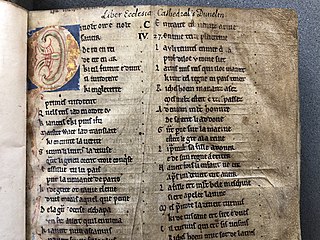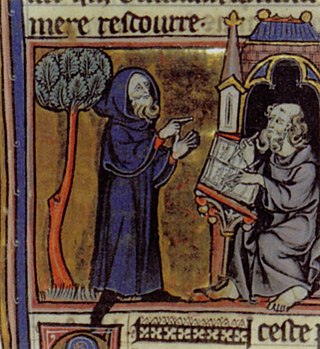
Excalibur is the mythical sword of King Arthur that may be attributed with magical powers or associated with the rightful sovereignty of Britain. Traditionally, the sword in the stone that is the proof of Arthur's lineage and the sword given him by a Lady of the Lake are not the same weapon, even as in some versions of the legend both of them share the name of Excalibur. Several similar swords and other weapons also appear within Arthurian texts, as well as in other legends.

King Arthur is a legendary king of Britain, and a central figure in the medieval literary tradition known as the Matter of Britain.

Merlin is a mythical figure prominently featured in the legend of King Arthur and best known as a magician, with several other main roles. The familiar depiction of Merlin, based on an amalgamation of historic and legendary figures, was introduced by the 12th-century British pseudo-historical author Geoffrey of Monmouth and then built on by the French poet Robert de Boron and their prose successors in the 13th century.

The Lady of the Lake is a name or a title used by several either fairy or fairy-like but human enchantresses in the Matter of Britain, the body of medieval literature and mythology associated with the legend of King Arthur. She plays several important roles in many stories, including providing Arthur with the sword Excalibur, eliminating Merlin, raising Lancelot after the death of his father, and helping to take the dying Arthur to Avalon. Different sorceresses known as the Lady of the Lake appear concurrently as separate characters in some versions of the legend since at least the Post-Vulgate Cycle and consequently the seminal Le Morte d'Arthur, with the latter describing them as a hierarchical group, while some texts also give this title to either Morgan or her sister.

The Matter of Britain is the body of medieval literature and legendary material associated with Great Britain and Brittany and the legendary kings and heroes associated with it, particularly King Arthur. The 12th-century Welsh cleric Geoffrey of Monmouth's Historia Regum Britanniae, widely popular in its day, is a central component of the Matter of Britain.

Le Morte d'Arthur is a 15th-century Middle English prose reworking by Sir Thomas Malory of tales about the legendary King Arthur, Guinevere, Lancelot, Merlin and the Knights of the Round Table, along with their respective folklore. In order to tell a "complete" story of Arthur from his conception to his death, Malory compiled, rearranged, interpreted and modified material from various French and English sources. Today, this is one of the best-known works of Arthurian literature. Many authors since the 19th-century revival of the legend have used Malory as their principal source.

The historicity of King Arthur has been debated both by academics and popular writers. While there have been many claims that King Arthur was a real historical person, the current consensus among specialists on the period holds him to be a mythological or folkloric figure.

The Lancelot-Grail Cycle, also known as the Vulgate Cycle or the Pseudo-Map Cycle, is an early 13th-century French Arthurian literary cycle consisting of interconnected prose episodes of chivalric romance originally written in Old French. The work of unknown authorship, presenting itself as a chronicle of actual events, retells the legend of King Arthur by focusing on the love affair between Lancelot and Guinevere, the religious quest for the Holy Grail, and the life of Merlin. The highly influential cycle expands on Robert de Boron's "Little Grail Cycle" and the works of Chrétien de Troyes, previously unrelated to each other, by supplementing them with additional details and side stories, as well as lengthy continuations, while tying the entire narrative together into a coherent single tale. Its alternate titles include Philippe Walter's 21st-century edition Le Livre du Graal.
Cligès is a poem by the medieval French poet Chrétien de Troyes, dating from around 1176. It is the second of his five Arthurian romances; Erec and Enide, Cligès, Yvain, Lancelot and Perceval. The poem tells the story of the knight Cligès and his love for his uncle's wife, Fenice.

The Brut or Roman de Brut by the poet Wace is a loose and expanded translation in almost 15,000 lines of Norman-French verse of Geoffrey of Monmouth's Latin History of the Kings of Britain. It was formerly known as the Brut d'Engleterre or Roman des Rois d'Angleterre, though Wace's own name for it was the Geste des Bretons, or Deeds of the Britons. Its genre is equivocal, being more than a chronicle but not quite a fully-fledged romance.
Meliodas is a figure in Arthurian legend in the 12th-century Prose Tristan and subsequent accounts. In Thomas Malory's Le Morte d'Arthur, he is the second king of Lyonesse, son of Felec of Cornwall and vassal of King Mark. Meliodas' first wife, Elizabeth, who bore the hero Tristan, was Mark's sister, and his second wife was a daughter or sister of Hoel of Brittany. He is the eponymous protagonist of the romance Meliadus. The Italian variant Tristano Riccardiano calls him Felix (Felissi).
Perlesvaus, also called Li Hauz Livres du Graal, is an Old French Arthurian romance dating to the first decade of the 13th century. It purports to be a continuation of Chrétien de Troyes' unfinished Perceval, the Story of the Grail, but it has been called the least canonical Arthurian tale because of its striking differences from other versions.

Merlin is a partly lost French epic poem written by Robert de Boron in Old French and dating from either the end of the 12th or beginning of the 13th century. The author reworked Geoffrey of Monmouth's material on the legendary Merlin, emphasising Merlin's power to prophesy and linking him to the Holy Grail. The poem tells of his origin and early life as a redeemed Antichrist, his role in the birth of Arthur, and how Arthur became King of Britain. Merlin's story relates to Robert's two other reputed Grail poems, Joseph d'Arimathie and Perceval. Its motifs became popular in medieval and later Arthuriana, notably the introduction of the sword in the stone, the redefinition of the Grail, and turning the previously peripheral Merlin into a key character in the legend of King Arthur.
Guiron le Courtois is a character in Arthurian legend, a knight-errant and one of the central figures in the French romance known as Palamedes, with later versions named Guiron le Courtois and the Compilation of Rustichello da Pisa. In the course of his adventures he becomes the companion of Danyn the Red, Lord of the Castle of Malaonc, whose wife, the Lady of Malaonc, is the most beautiful woman in Britain. Guiron and the lady fall in love, but the courteous knight remains loyal to his friend Danyn. Later both knights fall in love with the lady Bloye, but this time Guiron triumphs, though the couple are imprisoned and the story continues with the adventures of their son, also named Guiron.

The Legend of King Arthur is a British television fantasy serial, produced by the BBC in association with Time-Life Television and the Australian Broadcasting Commission, and broadcast on BBC 1 in 1979.
Le Roman du Comte d'Artois is a Middle French chivalric romance, composed between 1453 and 1467.
Anne Berthelot is a French professor of Medieval French literature and studies. She is currently teaching at the University of Connecticut since 1990.
Sebile, alternatively written as Sedile, Sebille, Sibilla, Sibyl, Sybilla, and other similar names, is a mythical medieval queen or princess who is frequently portrayed as a fairy or an enchantress in the Arthurian legend and Italian folklore. She appears in a variety of roles, from the most faithful and noble lady to a wicked seductress, often in relation with or substituting for the character of Morgan le Fay. Some tales feature her as a wife of either King Charlemagne or Prince Lancelot, and even as an ancestor of King Arthur.
L'âtre périlleux is an anonymous 13th century poem written in Old French in which Gawain is the hero. The name comes from just one of the adventures Gawain takes part in. Forced to spend the night in a chapel in a cemetery, he encounters a woman who has been cursed and is forced to spend the night with a devil each night. He defeats the devil and liberates her. The story draws on influences from other Arthurian romances, such as those of Raoul de Houdenc and Chrétien de Troyes.
Joufroi de Poitiers or Joufrois is a 13th-century French romance in 4613 octosyllabic verses. Only one manuscript of this work is preserved, in the Royal Library, Copenhagen, and this gives the romance in an incomplete form.










